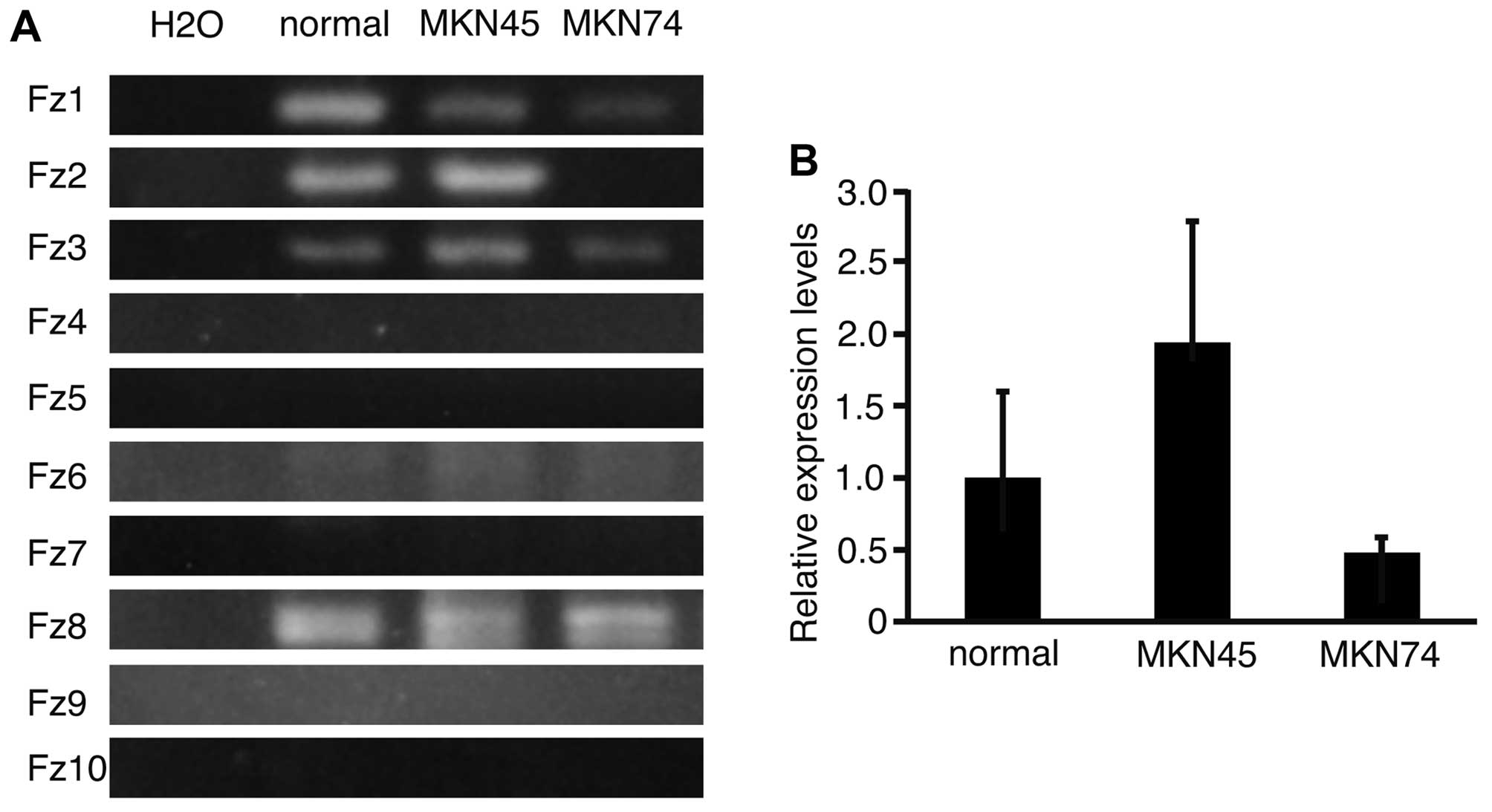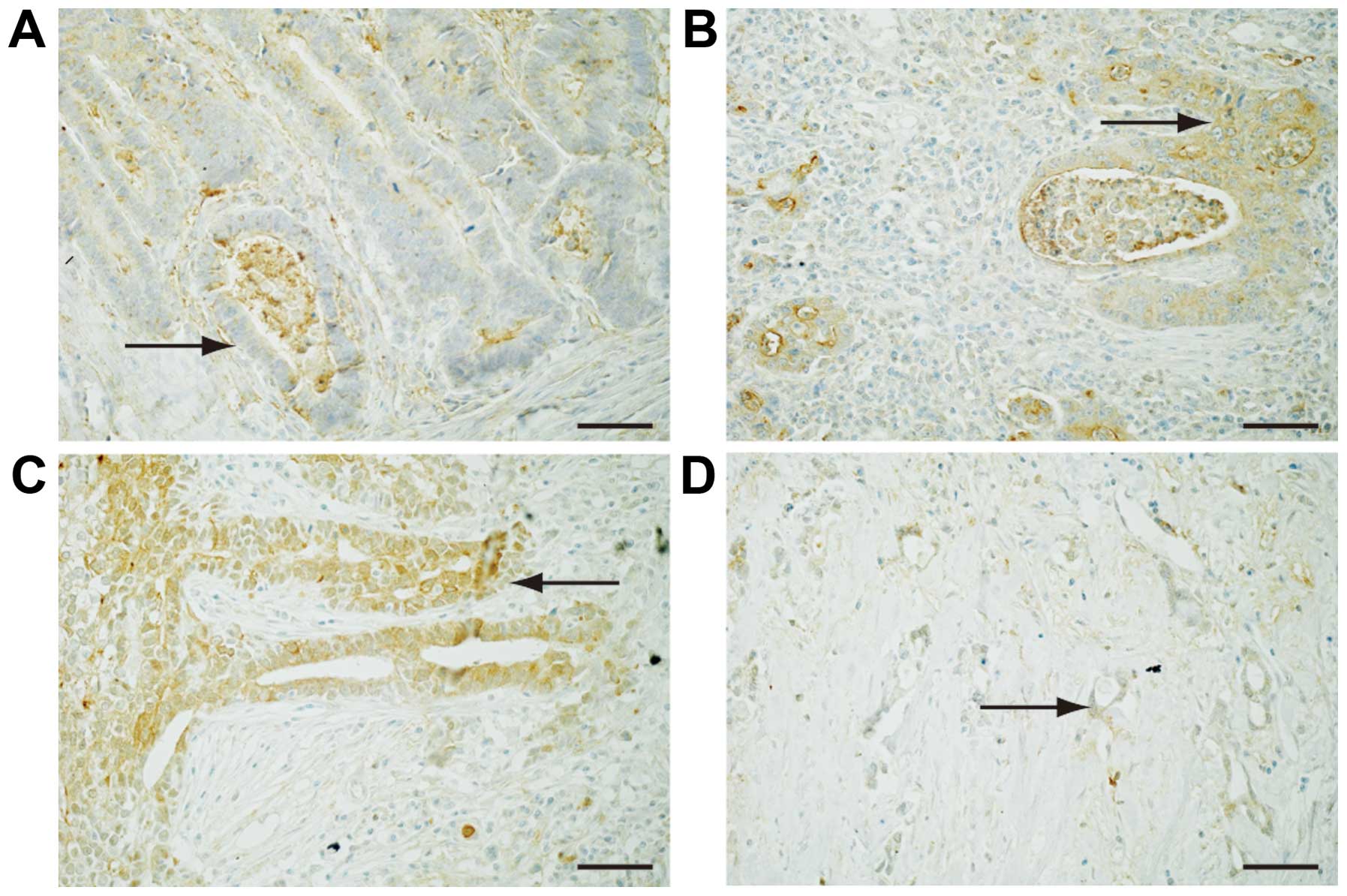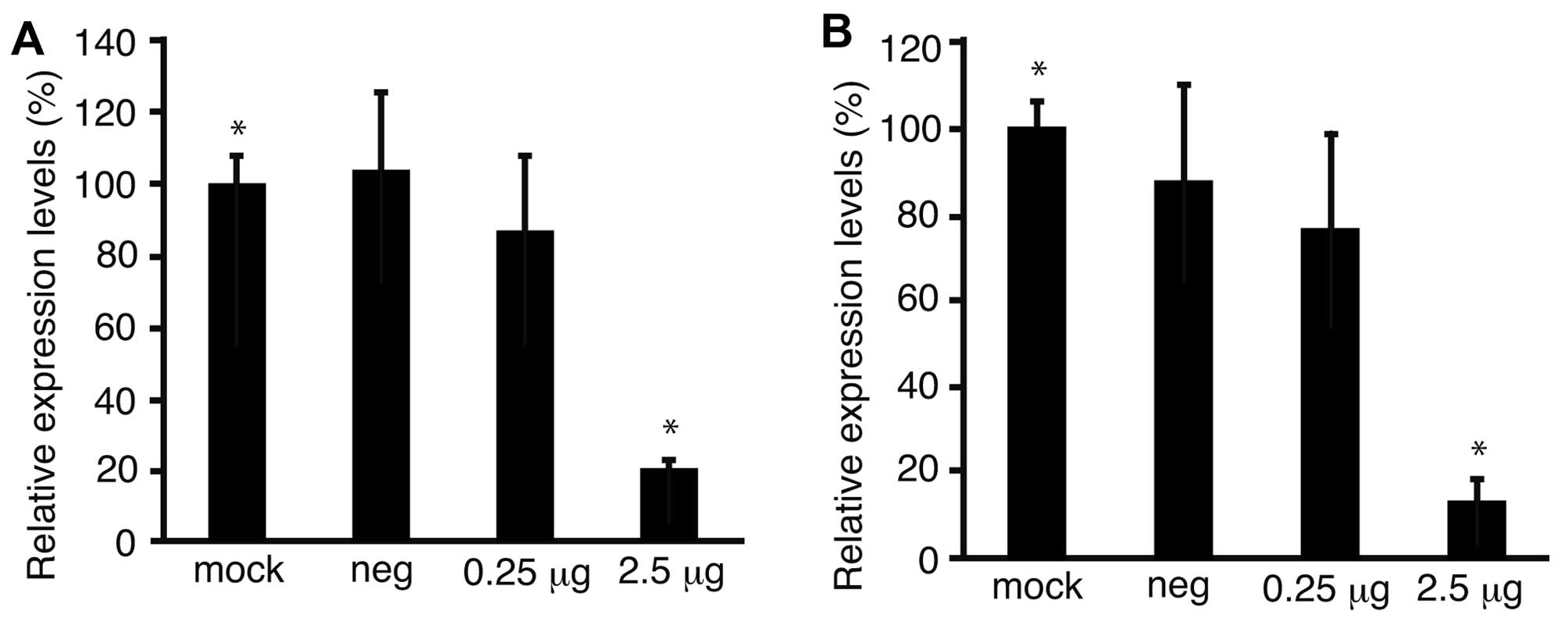Gastric cancer cell proliferation is suppressed by frizzled-2 short hairpin RNA
- Authors:
- Published online on: January 9, 2015 https://doi.org/10.3892/ijo.2015.2830
- Pages: 1018-1024
Abstract
Introduction
Gastric cancer (GC) accounts for 8% of total cases and 10% of total deaths from cancer worldwide (1). Although the endoscopic approach has improved cancer diagnosis and treatment, especially of early GC, prognosis is still poor for advanced types (2,3). Consequently, the development of effective molecular therapies for GC is eagerly awaited.
The Wnt pathway is involved in cell proliferation and differentiation (4). Wnt proteins bind to their receptor, frizzled (Fz), and its co-receptors, low-density lipoprotein receptor-related proteins 5 and 6 (LRP5/6), to form a complex (5,6). Once Wnt binds to its receptor complex, cytoplasmic β-catenin is accumulated through inhibition of its degradation by the glycogen synthase kinase (GSK)-3β complex (7). β-catenin acts as a co-factor of the T-cell factor (TCF)/lymphoid enhancer factor (LEF) and activates target genes (8). Activity of the Wnt pathway is also controlled by inhibition of secreted proteins such as dickkopf homolog-3 (9). Constitutive activation of the Wnt pathway leads to abnormal cell growth and the development of GC (10,11).
Wnt5a is upregulated in GC possibly due to demethylation of its promoter (12). The Fz3 and 6 receptors transduce the Wnt signal (13). Furthermore, the expression level of β-catenin has been shown to be upregulated in the MKN-45 GC cell line (14). Notably, upregulated β-catenin has been correlated with poor prognosis of patients with GC (14), and methylation of dickkopf homolog 3 has also been associated with poor prognosis of GC (15). Together, these reports clearly indicate that the Wnt pathway is activated in GC. It was, therefore, expected that inhibition of the Wnt pathway might be developed into a new molecular therapy for GC. In comparison, it has been shown that both downregulation of Fz2 and inhibitors of the Wnt pathway successfully suppress the proliferation of hepatocellular carcinoma and pancreatic cancer cells (16–19).
Therefore, we analyzed the effects of Fz2 inhibition using short hairpin RNA (shRNA) on the proliferation and motility of GC cell lines.
Materials and methods
This study was approved by the institutional ethics committee of the National Hospital Organization Shimoshizu Hospital, Yotsukaido City, Japan. Written informed consent was obtained by the commercial source (BioChain, Hayward, CA, USA).
Cell culture
The GC cell lines MKN45 and MKN74 were purchased from RIKEN Cell Bank (Tsukuba, Japan). Cells were cultured in Roswell Park Memorial Institute (RPMI)-1640 (Sigma, St. Louis, MO, USA) supplemented with 10% fetal bovine serum (FBS) (Life Technologies, Grand Island, NY, USA). Cell lines were cultured with 5% carbon dioxide at 37°C in a humidified chamber.
shRNA transfection
Cells were plated in 6-well plates (Asahi Techno Glass, Tokyo, Japan) and cultured until they reached 80% confluence, then transfected and cultured for an additional 48 h. Fz2 shRNA (OriGene, Rockville, MD, USA) was transfected into cells by using Lipofectamine LTX (Life Technologies), according to the manufacturer’s instructions. Briefly, shRNA was incubated with PLUS reagent for 5 min, after which LTX reagent was added. A 15-min incubation at room temperature ensued, and the complex was subsequently applied to the cell culture medium. An shRNA negative control was also purchased from OriGene.
RNA isolation, reverse transcription (RT-), and real-time quantitative polymerase chain reaction (PCR) amplification
Total RNA was isolated from native or transfected cell lines using Isogen (Nippon Gene, Tokyo, Japan), and 5 μg used to generate cDNA with SuperScript III and oligo(dT) primers, as per the manufacturer’s instructions (Life Technologies). Human whole stomach RNA was purchased from Clontech (Mountain View, CA, USA). PCR primers, annealing temperatures, reaction cycle numbers, and amplicon lengths are shown in Table I. PCR was performed using Taq DNA polymerase (Life Technologies), and products were subjected to analysis by gel electrophoresis in 2% agarose in 1X TAE (40 mM Tris-acetate/1 mM EDTA). Real-time quantitative PCR was performed using the Fast SYBR Green Master Mix (Life Technologies) and analyzed with the MiniOpticon Detection system (Bio-Rad, Hercules, CA, USA). Primer pairs for real-time quantitative PCR and the resultant product sizes were demonstrated in Table I. Real-time quantitative PCR was performed for 40 cycles with 5 sec denaturation at 95°C and 5 sec annealing/extension at 60°C. GAPDH and RPL19 were used as internal controls of RT-PCR and real-time quantitative PCR, respectively.
Immunostaining
Serial sections were cut from surgical samples, formalin-fixed, and embedded in paraffin (BioChain). The samples: well-differentiated adenocarcinoma (56-week-old female), moderately-differentiated adenocarcinoma (61-year-old female), poorly-differentiated adenocarcinoma (74-year-old male), and signet ring cells (62-year-old male) (BioChain) were deparaffinized, autoclaved, and incubated first with hydrogen peroxide, and then with 2% normal goat serum in phosphate-buffered saline (PBS) (washing buffer) for 30 min. After overnight incubation with a rabbit polyclonal anti-Fz2 antibody (1:5,000) (Sigma-Aldrich), specimens were rinsed with PBS and subsequently incubated with horseradish peroxidase-labeled anti-rabbit antibody (1:500) for 2 h (GE Healthcare, Pittsburgh PA, USA). Next, diaminobenzidine (Dako, Glostrup, Denmark) was applied to the tissue sections as a chromogen, and the nuclei were stained with hematoxylin (Muto Pure Chemicals Co., Ltd., Tokyo, Japan) for 15 sec. Specimens were observed and photographed under an AX80 microscope (Olympus, Tokyo, Japan).
Cell proliferation analysis
Cells were trypsinized, harvested, spread onto 96-well flat-bottom plates (Asahi Techno Glass) at a density of 1,000 cells per well, and incubated for 24 h in DMEM supplemented with 10% FBS. After culturing, cells were transfected with Fz2 shRNA for 72 h. Cell cultures were subjected to 3-(4,5-dimethylthiazol-2-yl)-5-(3-carboxymethoxyphenyl)-2-(4-sulfophenyl)-2H-tetrazolium inner salt (MTS) assays according to the manufacturer’s instructions (Promega Corp., Madison, WI, USA). MTS is bio-reduced by cells into a colored formazan product that reduces absorbance at 490 nm. Absorbance was analyzed at a wavelength of 490 nm with an iMark Microplate Absorbance Reader (Bio-Rad).
Scratch assay
Cells were plated on 4-well chamber slides (Becton-Dickinson, Franklin Lakes, NJ, USA). When cells reached confluence, they were scratched with 200 μl pipettes, incubated for 48 h and stained with hematoxylin and eosin. The stained slides were observed under an AX80 microscope (Olympus). The distance of the scratched line from the growing edge of the cells was measured at five different time points.
Statistical analysis
Cell proliferation and real-time quantitative PCR data were analyzed by a one-factor analysis of variance. Statistical analysis was performed using JMP5.0J software (SAS Institute, Cary, NC, USA). A P-value of <0.05 was set as statistically significant.
Results
To analyze the expression patterns of Fz genes in normal stomach, and in MKN45 and MKN74 cells, RT-PCR was performed and the products subjected to electrophoresis (Fig. 1A). Fz1, 3, 6 and 8 were expressed in normal stomach, and in MKN45 and MKN74 cell lines. Fz2 was expressed in normal stomach and in MKN45, but not in MKN74 cells. This result suggested that the expression of Fz2 varied between the cell lines. To determine the expression levels of Fz2 in normal stomach, and in MKN45 and MKN74 cell lines, real-time quantitative PCR was performed (Fig. 1B). The relative expression levels of Fz2 in MKN45 and MKN74 lines were 1.94±0.85 and 0.48±0.11 (mean ± standard deviation), respectively, as compared with that in normal stomach. It was therefore confirmed that expression of Fz2 was dependent on the cell line analyzed.
To reveal the expression of Fz2 in GC tissues, surgical specimens were immunostained with an antibody for the Fz2 protein (Fig. 2). Well-differentiated GC was weakly positive for Fz2 staining in the cell membranes (Fig. 2A). Fz2 staining was positive in both the cell membranes and the cytoplasm of GC tissues of moderately-differentiated and poorly-differentiated adenocarcinoma (Fig. 2B and C). Signet ring cells showed positive cytoplasmic staining for Fz2 (Fig. 2D). These results suggested that Fz2 was present in GC tissues, and that its expression levels are dependent on the grade of pathological differentiation.
To address the possibility that proliferation of GC cell lines might be suppressed with downregulation of Fz2, Fz2 shRNA was transfected into the GC MKN45 and MKN74 cell lines (Fig. 3). Proliferation of the MKN45 cell line was suppressed to 53.2±23.4% of that of mock transfected cells (P<0.05) at 100 ng/well MTS (Fig. 3A); similarly, proliferation of MKN74 cells was suppressed to 59.9±38.2% (P<0.05) of that of mock transfected cells at 100 ng/well MTS (Fig. 3B).
To confirm the downregulation of Fz2 by Fz2 shRNA, the expression levels of the Fz2 gene were quantitated. Expression levels of cyclin D1, involved in cell proliferation (20), were also analyzed. Quantitative real-time PCR demonstrated that the expression levels of Fz2 and cyclin D1 in MKN45 cells were downregulated to 64.9±15.9% (P<0.05) and 56.7±6.6% (P<0.05) of mock-transfected cells, respectively, at 2.5 μg/well Fz2 shRNA (Fig. 4A and B). In the MKN74 cell line, the expression levels of Fz2 and cyclin D1 were downregulated to 3.8±0.4% (P<0.05) and 3.7±0.8% (P<0.05) of those in mock-transfected cells, respectively, at 2.5 μg/well Fz2 shRNA (Fig. 4C and D).
To address the possibility that shRNA of Fz2 suppressed cell motility, a scratch assay was performed. Following transfection, the cell sheet was scratched and distance of migration was measured over a set time length (Fig. 5A–D). Distance of migration was suppressed from 607±102 μm in mock transfected MKN45 cells to 261±47 μm (P<0.05) at 2.5 μg/well Fz2 shRNA (Fig. 5E). Similarly, the distance of migration was suppressed from 209±43 μm in mock transfected MKN74 cells to 52±12 μm (P<0.05) at 2.5 μg/well Fz2 shRNA (Fig. 5F).
To reveal the mechanism of suppression of cell motility, the expression levels of MMP9, a gene involved in cancer metastasis (21), were quantitated. MMP9 was downregulated to 20.4±3.6% (P<0.05) and 13.8±2.8% (P<0.05) in MKN45 and MKN74 cells transfected with at 2.5 μg Fz2 shRNA, respectively, as compared with mock transfections (Fig. 6A and B).
Discussion
Expression patterns of Fz genes in normal stomach have not been reported (22–29). In our study, Fz1, 2, 3, 6 and 8 were shown to be expressed in normal stomach. It has previously been demonstrated that the GC cell lines MKN45 and MKN74 are positive for Fz3 expression using northern blot analysis (23). In the present study, we also demonstrated that both cell lines were positive for Fz3 expression using RT-PCR. Our data showed that MKN45 and MKN74 cells were negative and positive for Fz4 and Fz6 expression, respectively, consistent with previous reports (24,26).
In contrast, the present data showed that Fz2 was upregulated in the MKN45 GC cell line, but downregulated in MKN74. Fz2 was chosen for further analysis to address the possibility that downregulation of Fz2 might suppress the proliferation and motility of MKN45 and MKN74 cells. MTS and scratch assays clearly showed that Fz2 shRNA successfully suppressed the proliferation and motility of both cell lines. These results indicated that Fz2 might be a novel target for the development of molecular therapies for GC. We also observed Fz2-mediated downregulation of cyclin D1, which is involved in cell proliferation (20) and is also downregulated by an inhibitor of the Wnt pathway (17). These results and our data together suggested that Fz2 shRNA suppressed cell proliferation and motility via suppression of the Wnt pathway.
Our data clearly also demonstrated that MMP9, which has been established to be involved in cell motility (21), was downregulated by Fz2 shRNA in GC cell lines, which also demonstrated suppression of cell motility. As the expression of MMP9 is associated with the expression of Wnt3a in human primary lung cancer tissues (30), this, along with our results, suggested that MMP9 was a downstream target of the Wnt pathway.
One limitation of our study was that Fz2 was expressed in normal stomach. It was difficult to know what types of cells were positive for Fz1, 2, 3, 6 and 8. Stomach tissue is composed of mucous, muscle, and serous tissue, as well as nerves and blood vessels.
In conclusion, Fz2, 3, 6 and 8 were expressed in normal stomach, and in MKN45 and MKN74 GC cell lines. Fz2 shRNA suppressed cell proliferation and motility of MKN45 and MKN74 cells, and cyclin D1 and MMP9 expression was downregulated by Fz2 shRNA. Together, these results suggested that Fz2 might be a novel target for the development of molecular therapies for GC.
References
|
Jemal A, Bray F, Center MM, Ferlay J, Ward E and Forman D: Global cancer statistics. CA Cancer J Clin. 61:69–90. 2011. View Article : Google Scholar : PubMed/NCBI | |
|
Kim MY, Cho JH and Cho JY: Ever-changing endoscopic treatment for early gastric cancer: yesterday-today-tomorrow. World J Gastroenterol. 20:13273–13283. 2014. View Article : Google Scholar : PubMed/NCBI | |
|
De Vita F, Di Martino N, Fabozzi A, et al: Clinical management of advanced gastric cancer: the role of new molecular drugs. World J Gastroenterol. 20:14537–14558. 2014. View Article : Google Scholar : PubMed/NCBI | |
|
Gomez-Orte E, Saenz-Narciso B, Moreno S and Cabello J: Multiple functions of the noncanonical Wnt pathway. Trends Genet. 29:545–553. 2013. View Article : Google Scholar : PubMed/NCBI | |
|
Tanaka SS, Kojima Y, Yamaguchi YL, Nishinakamura R and Tam PP: Impact of WNT signaling on tissue lineage differentiation in the early mouse embryo. Dev Growth Differ. 53:843–856. 2011. View Article : Google Scholar : PubMed/NCBI | |
|
MacDonald BT, Tamai K and He X: Wnt/beta-catenin signaling: components, mechanisms, and diseases. Dev Cell. 17:9–26. 2009. View Article : Google Scholar : PubMed/NCBI | |
|
Takahashi-Yanaga F: Activator or inhibitor? GSK-3 as a new drug target. Biochem Pharmacol. 86:191–199. 2013. View Article : Google Scholar : PubMed/NCBI | |
|
Jamieson C, Sharma M and Henderson BR: Targeting the beta-catenin nuclear transport pathway in cancer. Semin Cancer Biol. 27:20–29. 2014. View Article : Google Scholar : PubMed/NCBI | |
|
Veeck J and Dahl E: Targeting the Wnt pathway in cancer: the emerging role of Dickkopf-3. Biochim Biophys Acta. 1825:18–28. 2012. | |
|
Katoh M and Katoh M: WNT signaling pathway and stem cell signaling network. Clin Cancer Res. 13:4042–4045. 2007. View Article : Google Scholar : PubMed/NCBI | |
|
Qu Y, Dang S and Hou P: Gene methylation in gastric cancer. Clin Chim Acta. 424:53–65. 2013. View Article : Google Scholar : PubMed/NCBI | |
|
Hibi K, Sakata M, Yokomizi K, et al: Methylation of the WNT5A gene is frequently detected in early gastric carcinoma. Hepatogastroenterology. 59:2661–2663. 2012.PubMed/NCBI | |
|
Katoh M: WNT/PCP signaling pathway and human cancer (review). Oncol Rep. 14:1583–1588. 2005.PubMed/NCBI | |
|
Cui J, Xi H, Cai A, Bian S, Wei B and Chen L: Decreased expression of Sox7 correlates with the upregulation of the Wnt/beta-catenin signaling pathway and the poor survival of gastric cancer patients. Int J Mol Med. 34:197–204. 2014.PubMed/NCBI | |
|
Yu J, Tao Q, Cheng YY, et al: Promoter methylation of the Wnt/beta-catenin signaling antagonist Dkk-3 is associated with poor survival in gastric cancer. Cancer. 115:49–60. 2009. View Article : Google Scholar | |
|
Fujimoto T, Tomizawa M and Yokosuka O: SiRNA of frizzled-9 suppresses proliferation and motility of hepatoma cells. Int J Oncol. 35:861–866. 2009.PubMed/NCBI | |
|
Tomizawa M, Shinozaki F, Motoyoshi Y, et al: Niclosamide suppresses Hepatoma cell proliferation via the Wnt pathway. Onco Targets Ther. 6:1685–1693. 2013. View Article : Google Scholar : PubMed/NCBI | |
|
Tomizawa M, Shinozaki F, Sugiyama T, Yamamoto S, Sueishi M and Yoshida T: Frizzled-2: A potential novel target for molecular pancreatic cancer therapy. Oncol Lett. 7:74–78. 2014. | |
|
Tomizawa M, Shinozaki F, Motoyoshi Y, Sugiyama T, Yamamoto S and Sueishi M: Short hairpin RNA of frizzled-2 suppresses the proliferation of hepatocellular carcinoma cells. Oncol Lett. 8:1519–1522. 2014.PubMed/NCBI | |
|
Casimiro MC, Velasco-Velazquez M, Aguirre-Alvarado C and Pestell RG: Overview of cyclins D1 function in cancer and the CDK inhibitor landscape: past and present. Expert Opin Investig Drugs. 23:295–304. 2014. View Article : Google Scholar : PubMed/NCBI | |
|
Vandooren J, Van den Steen PE and Opdenakker G: Biochemistry and molecular biology of gelatinase B or matrix metalloproteinase-9 (MMP-9): the next decade. Crit Rev Biochem Mol Biol. 48:222–272. 2013. View Article : Google Scholar : PubMed/NCBI | |
|
Sagara N, Toda G, Hirai M, Terada M and Katoh M: Molecular cloning, differential expression, and chromosomal localization of human frizzled-1, frizzled-2, and frizzled-7. Biochem Biophys Res Commun. 252:117–122. 1998. View Article : Google Scholar : PubMed/NCBI | |
|
Kirikoshi H, Koike J, Sagara N, et al: Molecular cloning and genomic structure of human frizzled-3 at chromosome 8p21. Biochem Biophys Res Commun. 271:8–14. 2000. View Article : Google Scholar : PubMed/NCBI | |
|
Kirikoshi H, Sagara N, Koike J, et al: Molecular cloning and characterization of human Frizzled-4 on chromosome 11q14-q21. Biochem Biophys Res Commun. 264:955–961. 1999. View Article : Google Scholar : PubMed/NCBI | |
|
Saitoh T, Hirai M and Katoh M: Molecular cloning and characterization of human Frizzled-5 gene on chromosome 2q33.3-q34 region. Int J Oncol. 19:105–110. 2001.PubMed/NCBI | |
|
Tokuhara M, Hirai M, Atomi Y, Terada M and Katoh M: Molecular cloning of human Frizzled-6. Biochem Biophys Res Commun. 243:622–627. 1998. View Article : Google Scholar : PubMed/NCBI | |
|
Saitoh T, Hirai M and Katoh M: Molecular cloning and characterization of human Frizzled-8 gene on chromosome 10p11.2. Int J Oncol. 18:991–996. 2001.PubMed/NCBI | |
|
Wang YK, Samos CH, Peoples R, Perez-Jurado LA, Nusse R and Francke U: A novel human homologue of the Drosophila frizzled wnt receptor gene binds wingless protein and is in the Williams syndrome deletion at 7q11.23. Hum Mol Genet. 6:465–472. 1997. View Article : Google Scholar : PubMed/NCBI | |
|
Koike J, Takagi A, Miwa T, Hirai M, Terada M and Katoh M: Molecular cloning of Frizzled-10, a novel member of the Frizzled gene family. Biochem Biophys Res Commun. 262:39–43. 1999. View Article : Google Scholar : PubMed/NCBI | |
|
Lee MA, Park JH, Rhyu SY, Oh ST, Kang WK and Kim HN: Wnt3a expression is associated with MMP-9 expression in primary tumor and metastatic site in recurrent or stage IV colorectal cancer. BMC Cancer. 14:1252014. View Article : Google Scholar : PubMed/NCBI |
















